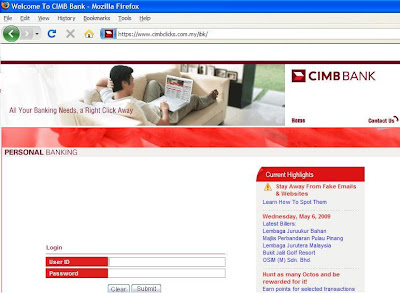Nowadays internet banking is widely used. Many transaction can be done online. However don't be fooled by fake internet banking website or invalid link sent to your email.
These are some of the fake Internet banking website in Malaysia:
- http://www.may2u-malaysia.com/May-Bank-Online.htm
- http://www.online-may2younet.com/May-Bank-Online.htm
- http://www.may2u-securednet.com/Maybank2u.htm
- http://www.mayberhad-verifications.com/May-Bank-Online.htm
- http://www.may2u-onlineprotections.com/Maybank2u.htm
- http://www.may2u-newnet-securities.com/Maybank2u.htm
- http://www.may2u-newupdates.com/Maybank2u-Online.htm
- http://www.may2u-newsolutions.com/Maybank2u-Online.htm
- http://marchantschmidt.com/photos/mainn/Maybank2u_com.html
- http://210.217.236.12/wmaster/pop/mayredi.html
- http://chrysantheme.guilde.free.fr/phpraider//authentication/smf/mbb_login.htm
- http://lordsofexodar.free.fr//images/mbb_login.htm
Now compare this CIMB website:
1.Fake CIMBCLICKS website
With this:
2. Official CIMBCLICKS website
Compare again, now its turn for Maybank 2u
Can you spot the difference? The fake website looks the same with the real one. So be careful
These look exactly like that of Malaysian banks’ e-banking websites. These phishing websites or fake websites are used to conduct a “phishing attack”, which involves manipulating the weak side of human security. This is done by masquerading as a trustworthy entity, for example, a copycat of a familiar banking website.
The “phishing attack” also uses a kind of social engineering tactic, such as sending spam emails that look as though they have been sent by a well-known Malaysian bank
Now check your e-mail: Don't get fooled by these e-mail:
Example of phishing email scam
The email tricks people into clicking on a link that will open up the phishing website or fake e-banking website. As the fake website looks exactly like the original, customers enter confidential information such as e-banking usernames and passwords into the fake e-banking website.
This way, the “phishing attacker” steals usernames and passwords of bank customers. CyberSecurity Malaysia chief executive officer Lt-Col (Rtd) Husin Jazri said: “If you do receive such emails and they look like they are from banks or financial institutions, our advice is to ignore them.
Protect yourself by always following a few key rules of thumb when you’re online:
- Use an up-to-date browser that features an anti-phishing black list. Some examples include Internet Explorer 8 or Firefox 3.0.10.
- Use unique logins and passwords for each of the websites you use.
- Check to see that you’re logging in from a legitimate e-banking site page for example the www.maybank2u.com.my domain not www.maybank2you.com.my
- Be cautious of any message, post or link you find on your e-mail that looks suspicious or requires an additional login.
Thats all for this entry. Enjoy your browsing and do your transaction safely




No comments:
Post a Comment